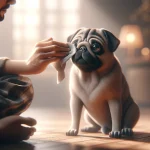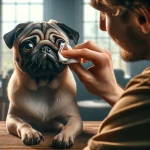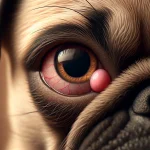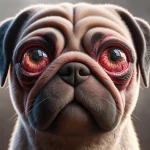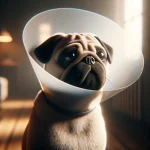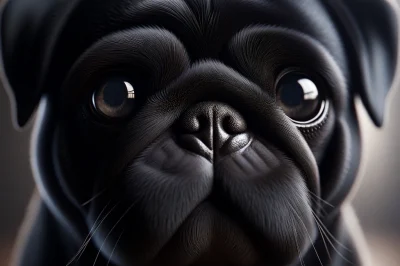
Below is a list of health terms used when describing various eye conditions:
Table of Contents
Cherry Eye
Cherry eye is a common eye condition seen in many dog breeds, including Pugs, characterized by the prolapse of the third eyelid’s gland. This gland, also known as the nictitating membrane, is responsible for producing a significant portion of the eye’s protective tear film. When it prolapses, or pops out of its normal position, it creates a noticeable red bulge in the corner of the eye, resembling a cherry—hence the name “cherry eye.”
Causes and Risk Factors
While the exact cause of cherry eye is not fully understood, it is believed to be related to the connective tissue’s weakness within the eye, allowing the gland to prolapse. Breeds like Pugs, with their distinctive facial structures and eye shapes, are predisposed to this condition.
Symptoms
The most obvious sign of cherry eye is the appearance of a red, swollen mass at the inner corner of the eye. This may occur in one or both eyes and can lead to further symptoms if left untreated, including:
- Irritation and discomfort
- Eye discharge
- Dry eye (Keratoconjunctivitis Sicca) due to reduced tear production if the gland is not functioning properly
- Potential secondary infections or conjunctivitis
Treatment
Treatment for cherry eye typically involves surgical correction to reposition the prolapsed gland back into its normal location. There are different surgical techniques used, but the goal is always to preserve the gland’s function to maintain adequate tear production for the eye. Complete removal of the gland was once practiced but is now avoided when possible due to the high risk of developing dry eye syndrome, which can be a more challenging condition to manage.
Recovery and Management
Post-operative care is crucial for ensuring a successful recovery. This may include:
- Keeping the eye clean and administering prescribed eye drops or ointments to prevent infection and reduce inflammation.
- Using an Elizabethan collar (E-collar) to prevent the dog from scratching or rubbing the eye, which can interfere with healing.
- Close monitoring for any signs of complications or recurrence of the prolapse.
Prevention
There are no guaranteed methods to prevent cherry eye given its largely hereditary nature, but early detection and treatment can prevent further complications and discomfort. Regular veterinary check-ups can help catch this and other eye conditions early, maintaining your Pug’s eye health and overall quality of life.
Entropion
Entropion is a condition characterized by the inward rolling of the eyelid, which causes the eyelashes and skin to rub against the cornea (the clear outer layer of the eye). This can lead to discomfort, irritation, and potentially more serious eye problems, such as corneal ulcers or infections. In Pugs, and similar brachycephalic breeds with their distinct facial structure, entropion is a relatively common issue. Their unique head shape and skin folds can predispose them to this condition.
Symptoms of entropion in Pugs may include:
- Eye discharge: You might notice watery, mucus, or pus-like discharge from the affected eye.
- Squinting or blinking excessively: This is a sign of eye discomfort or pain.
- Redness and swelling: The eye area may appear inflamed.
- Rubbing or pawing at the face: Your Pug may try to relieve discomfort by rubbing its face against objects or using its paws.
- Corneal opacity: Advanced cases may lead to visible changes in the cornea, such as cloudiness or scarring.
The treatment for entropion usually involves surgical correction to properly reposition the eyelid. This surgery adjusts the eyelid’s position to prevent it from rolling inward and causing harm to the cornea. The procedure’s specifics can vary depending on the severity of the entropion and the individual dog’s needs.
Post-operative care is crucial for a successful recovery and typically includes:
- Keeping the eye clean and administering any prescribed medications, such as antibiotics or eye drops, to prevent infection and reduce inflammation.
- Using an Elizabethan collar (E-collar) to prevent your Pug from scratching or rubbing the affected eye, allowing the surgical site to heal properly.
- Follow-up visits to the veterinarian to ensure the eye is healing correctly and to assess the success of the surgical correction.
Preventing entropion can be challenging since it is often related to the dog’s genetic makeup and breed-specific facial structure. However, being vigilant about eye health, ensuring prompt treatment of any eye infections or inflammation, and regular veterinary check-ups can help manage the condition and prevent complications.
As a Pug owner, being aware of the signs of entropion and seeking veterinary advice early can make a significant difference in managing this condition and maintaining your dog’s eye health.
Distichiasis (Ingrown Eyelashes)
Distichiasis is a condition where eyelashes grow from an abnormal spot on the eyelid, often turning inward towards the eye rather than outward. This can lead to discomfort, irritation, and potentially more serious eye problems for your Pug. Given the unique facial structure and eye characteristics of Pugs, they can be particularly susceptible to issues like distichiasis.
Causes and Diagnosis
Distichiasis can be congenital (the dog is born with it) or develop later in life. In Pugs, the condition is often inherited, linked to their distinctive facial features. The ingrown eyelashes can rub against the cornea (the clear front part of the eye) and the conjunctiva (the lining of the inner eyelids and the white part of the eye), causing irritation.
Veterinarians typically diagnose distichiasis by conducting a thorough eye examination, which may include using specialized equipment to get a detailed look at the eyelashes and their impact on the eye. In some cases, staining may be used to highlight any scratches or ulcers on the cornea caused by the lashes.
Symptoms
Symptoms of distichiasis in Pugs can include:
- Eye redness
- Excessive tearing or discharge
- Blinking more than usual or squinting
- Rubbing at the eyes
- Visible irritation or discomfort
Treatment Options
Treatment for distichiasis depends on the severity of the symptoms and the extent of discomfort or damage to the eye. Options include:
- Lubricants: Eye drops or ointments can be used to lubricate the eyes, helping to soothe irritation and protect the cornea.
- Manual Removal: Sometimes, if there are only a few problematic lashes, they can be plucked out. However, this is a temporary solution, as the lashes often grow back.
- Electrolysis or Cryosurgery: These are more permanent solutions where the hair follicles are destroyed to prevent the lashes from regrowing. Electrolysis uses electrical current, while cryosurgery uses extreme cold. Both procedures are delicate and should be performed by a veterinarian experienced in ophthalmic surgeries.
- Surgical Correction: In some cases, more extensive surgery may be necessary to reposition the eyelids or remove larger sections of problematic lashes.
The Importance of Veterinary Care
If you suspect your Pug may be suffering from distichiasis, it’s crucial to seek veterinary care. Early intervention can help prevent more serious complications, such as corneal ulcers, which could lead to vision loss. Regular check-ups and prompt treatment of eye issues are key to maintaining the health and comfort of your Pug’s eyes.
Keratoconjunctivitis Sicca (KCS) – (Dry Eye)
Keratoconjunctivitis Sicca (KCS), also known as “dry eye,” is a condition characterized by decreased tear production, leading to dryness and inflammation of the cornea and the conjunctiva (the tissues surrounding the eye). In Pugs, whose eyes are more exposed due to their facial structure, KCS can be particularly concerning. The condition can result in discomfort, chronic irritation, and, if left untreated, can lead to serious eye damage including corneal ulcers and vision loss.
Symptoms of KCS in Pugs
Owners may notice several signs indicating KCS in their Pugs, including:
- Eye redness: The eye(s) may appear more red than usual due to irritation.
- Discharge: Thick, mucoid or pus-like discharge is common, as the eye attempts to compensate for the lack of tears.
- Frequent blinking or squinting: This can be a sign of discomfort or an attempt to moisten the eye.
- Rubbing at the eyes: Pugs may paw at their eyes or rub their face against objects to alleviate discomfort.
- Cloudy or dull eye appearance: The cornea may lose its shine and transparency due to persistent dryness.
Causes
KCS can be caused by a variety of factors, including immune-mediated diseases that affect the tear-producing glands, certain medications, systemic diseases, or as a result of congenital issues common in brachycephalic breeds like Pugs.
Diagnosis and Treatment
Diagnosis of KCS typically involves measuring tear production using a Schirmer Tear Test (STT), where a special strip of paper is placed in the lower eyelid to measure tear production over a specific period.
Treatment aims to stimulate tear production and provide artificial lubrication to protect the eye. Common treatments include:
- Tear stimulants: Medications such as cyclosporine or tacrolimus can help stimulate natural tear production.
- Artificial tear solutions: Regular application of artificial tears or lubricating ointments to keep the eyes moist and protect the cornea.
- Antibiotics or anti-inflammatory medications: These may be prescribed if there is an infection or significant inflammation.
In severe cases where medical management is not sufficient, surgical options may be considered to provide long-term lubrication to the eye.
Management
Managing KCS in Pugs requires a commitment to regular treatment and monitoring. Consistent application of medications, as prescribed by your veterinarian, is crucial for keeping your Pug’s eyes healthy and comfortable. Regular veterinary check-ups are essential to adjust treatment as needed and to monitor the condition of the eyes over time.
Proptosis
Proptosis is a serious eye condition that occurs when an eye is dislodged from its socket, leading to its displacement forward. This condition is especially prevalent in brachycephalic breeds, like Pugs, due to their unique head and skull shape. These breeds have shallow eye sockets, making their eyes more vulnerable to popping out even with minor trauma or excessive pressure on the neck.
When an eye proptoses, it is an emergency that requires immediate veterinary attention. The displaced eye may look swollen, and you might notice that your Pug is unable to blink over the affected eye, which can lead to dryness and damage to the cornea. The eyelids can also become trapped behind the eyeball, further complicating the situation.
Treatment typically involves trying to replace the eye back into its socket under general anesthesia. This might be accompanied by treatments to address inflammation, infection, and pain. In some cases, if the damage to the eye is too severe, or if the eye’s blood supply is compromised, removal of the eye may be necessary to prevent further complications and alleviate pain.
Aftercare is crucial for a dog that has experienced proptosis. This might include administering medications like antibiotics and anti-inflammatories, and possibly wearing a cone to prevent rubbing or scratching the affected eye. Regular follow-up visits to the veterinarian are necessary to monitor the eye’s healing and to adjust treatments as needed.
As a Pug owner, it’s important to be aware of this risk and take preventive measures to protect your dog from situations that could lead to proptosis. This includes using a harness instead of a neck collar to reduce pressure on the neck and being cautious to avoid situations where your dog might sustain head or facial injuries.
- Eye discharge: You might notice watery, mucus, or pus-like discharge from the affected eye.
- Squinting or blinking excessively: This is a sign of eye discomfort or pain.
- Redness and swelling: The eye area may appear inflamed.
- Rubbing or pawing at the face: Your Pug may try to relieve discomfort by rubbing its face against objects or using its paws.
- Corneal opacity: Advanced cases may lead to visible changes in the cornea, such as cloudiness or scarring.
The treatment for entropion usually involves surgical correction to properly reposition the eyelid. This surgery adjusts the eyelid’s position to prevent it from rolling inward and causing harm to the cornea. The procedure’s specifics can vary depending on the severity of the entropion and the individual dog’s needs.
Post-operative care is crucial for a successful recovery and typically includes:
- Keeping the eye clean and administering any prescribed medications, such as antibiotics or eye drops, to prevent infection and reduce inflammation.
- Using an Elizabethan collar (E-collar) to prevent your Pug from scratching or rubbing the affected eye, allowing the surgical site to heal properly.
- Follow-up visits to the veterinarian to ensure the eye is healing correctly and to assess the success of the surgical correction.
Preventing entropion can be challenging since it is often related to the dog’s genetic makeup and breed-specific facial structure. However, being vigilant about eye health, ensuring prompt treatment of any eye infections or inflammation, and regular veterinary check-ups can help manage the condition and prevent complications.
Schirmer Tear Test
The Schirmer Tear Test is a simple and non-invasive procedure used by veterinarians to measure tear production in dogs, which is essential for diagnosing conditions like Dry Eye Syndrome (Keratoconjunctivitis Sicca or KCS). For Pug owners, understanding this test is important, as Pugs, with their unique eye structure and facial anatomy, are more prone to eye issues that can affect tear production.
During the Schirmer Tear Test, a small, specially designed strip of paper is gently placed under the lower eyelid of each eye. Your dog may feel a bit of discomfort, but the process is generally not painful and only takes about a minute. The paper strip has markings on it, which allow the veterinarian to measure how much tear fluid wets the strip over a specified period, usually 60 seconds.
Normal tear production will wet a significant portion of the strip, indicating that the eyes are producing enough tears to keep them moist, nourished, and free of debris. If the strip remains relatively dry, it suggests that the tear production is below normal, which could lead to dry eye conditions. Dry eye can be uncomfortable or even painful for your Pug, leading to symptoms such as irritation, redness, discharge, and potentially more serious complications if left untreated.
For Pugs, maintaining proper eye moisture is crucial due to their prominent eyes, which are more exposed to the environment and thus at a higher risk of injury and infection. Low tear production can exacerbate these risks, making early detection and treatment vital.
If your Pug is diagnosed with KCS or another condition affecting tear production, your veterinarian may recommend various treatments to help manage the condition. These treatments can include artificial tear solutions, medications to stimulate tear production, or, in some cases, surgery. Regular follow-up visits will likely be necessary to monitor the condition and adjust treatment as needed.
Tear Stains
Several factors can contribute to excessive tearing and subsequent staining in Pugs:
- Facial Structure: Pugs have short noses and deep facial folds, which can contribute to tear duct issues or cause tears to spill onto the face rather than drain properly.
- Eye Protrusion: The breed’s prominent eyes can lead to greater exposure to irritants and more rapid evaporation of tears, resulting in increased tear production.
- Health Issues: Conditions such as infections, allergies, or even ingrown eyelashes (distichiasis) can increase tear production. It’s crucial to rule out these underlying issues with your veterinarian.
Managing Tear Stains
Here are some steps you can take to manage and reduce tear staining in your Pug:
- Regular Cleaning: Gently wipe the area under your Pug’s eyes daily with a soft, damp cloth to remove any debris and prevent stains from setting. Special tear stain removers are available but consult your vet for a recommendation to ensure it’s safe for your pet.
- Veterinary Check-ups: Regular check-ups can help identify and treat any underlying issues contributing to excessive tearing, such as infections or anatomical problems.
- Proper Diet and Water: Sometimes, diet can influence tear staining. Offering high-quality dog food and filtered water can help reduce tear staining for some dogs.
- Keep Facial Folds Dry: Due to Pugs’ facial structure, it’s essential to keep their facial folds dry to prevent irritation and infection, which can exacerbate tear production. Gently clean and dry these areas regularly.
When to Seek Veterinary Help
If your Pug’s tear staining is accompanied by signs of discomfort, such as rubbing the eyes, squinting, or excessive discharge, or if you notice a sudden increase in tear production, it’s important to consult with your veterinarian. These could be signs of an underlying health issue that needs to be addressed.
- Best Pug Tear Stain Removers: Safe & Effective Solutions – 15 March 2024
- Pug Cherry Eye Surgery Success Guide & Post-Procedure Expectations – 14 March 2024
- Pug Dry Eye Treatment: Effective Tips, Tricks & Remedies – 13 March 2024

